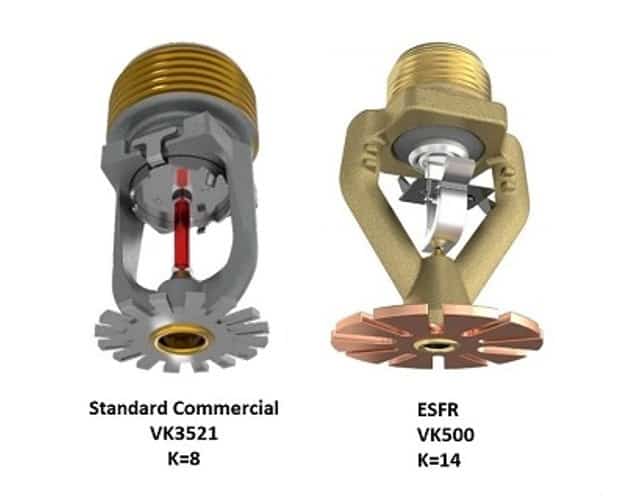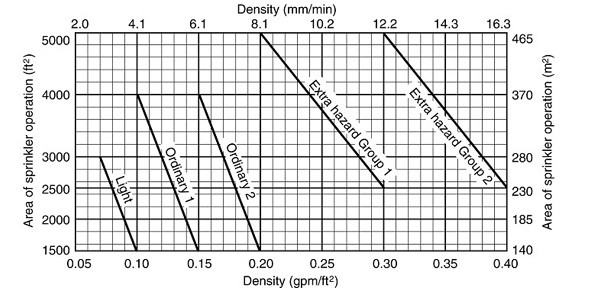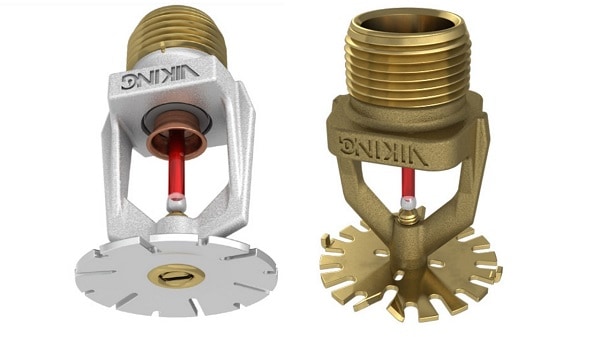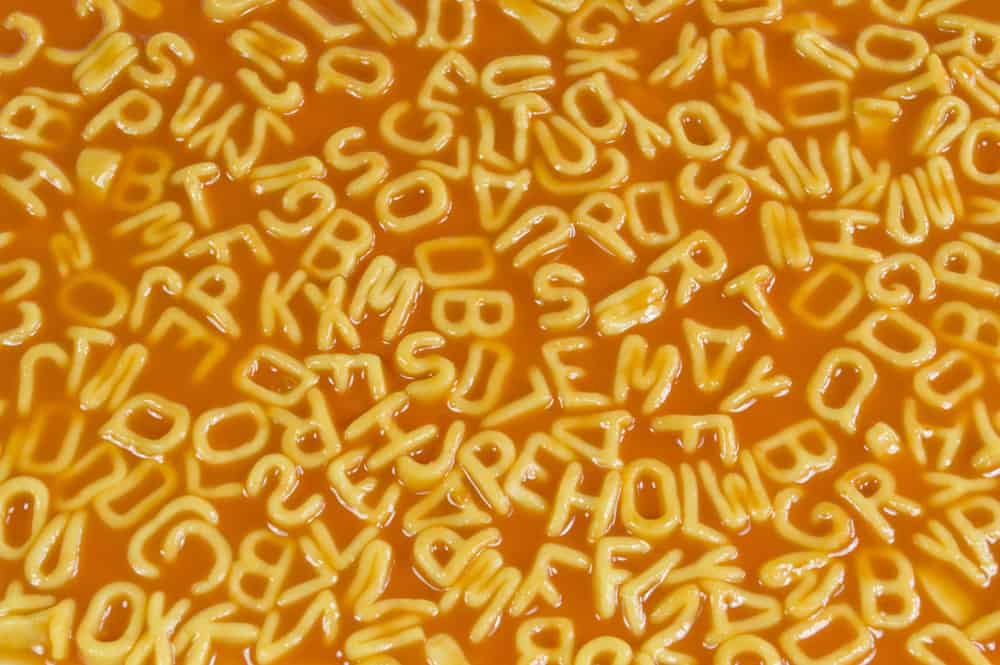ELO, ESFR, ECOH. What do those letters mean, and what are the differences between these sprinkler heads?
Like the US government and military, the fire protection industry is filled with acronyms many people don’t understand. This article explains three potentially confusing acronyms attached to fire sprinklers: ELO, ESFR, and ECOH. They may all start with “E,” but these leading letters and entire acronyms represent significantly different things.
Read on to learn what they stand for, plus how these sprinkler heads are used and fill a niche in fire protection. NFPA 13: Standard for the Installation of Fire Protection Systems (mostly the 2022 edition) will be the primary source referenced throughout this blog.
But first, a quick summary:
- ELO stands for extra-large orifice, meaning a sprinkler with a K-factor of at least 11.2
- ESFR stands for early suppression fast response, which is a type of sprinkler used to suppress fires in high-challenge storage areas
- ECOH stands for extended coverage ordinary hazard, a label used for extended coverage sprinklers specifically approved for use in ordinary-hazard occupancies—a somewhat smaller segment of most extended coverage models, which are used in light-hazard occupancies.
QRFS is ready to supply ELO, ESFR, and ECOH sprinklers for your next project. Shop our extensive catalog or contact our customer service team today to discuss your needs and request a quote.
ELO sprinklers help deliver more water
ELO stands for “extra-large orifice.” In plain English, ELO sprinklers have very big holes for water to flow through.
The size of a sprinkler orifice is described in two ways: nominal orifice size and nominal K-factor. Many common sprinklers have an orifice size of 0.5” or 17/32”, which, per NFPA 13’s Table 7.2.2.1 (2019), correspond to K-factors of 5.6 and 8.0, respectively. In contrast, the minimum nominal orifice size and K-factor of an ELO sprinkler are bigger: 0.64” and 11.2 K. We’ll refer to the K-factor from now on, as more people are used to this unit.
Outside of this size distinction, there’s little to distinguish an ELO sprinkler from any other kind of sprinkler. In fact, NFPA 13 does not explicitly define “extra-large orifice sprinklers” in the way it defines dry sprinklers, ESFR sprinklers, or residential sprinklers. But you’ll typically see the term “ELO” applied to control mode density/area (CMDA) sprinklers.
CMDA sprinklers, which you can read more about in our previous blog entry, are spray sprinklers that use the density/area concept to protect storage occupancies. As NFPA 13 (2022: A.3.3.205.4.1) indicates, CMDA sprinklers typically need a K-factor of at least 11.2 to deliver enough water to hit the larger discharge densities demanded in high-challenge fire environments. Thus, many of Viking’s CMDA sprinklers are also marked ELO.
As you might guess, the major benefit of an ELO sprinkler is increased water flow compared to normal-sized orifice sprinklers. This is evident from the K-factor formula:
Q = K * √ P
Where: Q is the water flow in gallons per minute (GPM), P is the water pressure in pounds per square inch (PSI), and K is the K-factor.
The 11.2 K-factor of an ELO sprinkler is double that of a 5.6 sprinkler, so an ELO will flow (at least) twice the amount of water.
This increased flow provides many advantages. As Viking explains, ELO sprinklers enable sprinkler designers to achieve greater water flow with less pressure. This helps save money and complexity by (potentially) eliminating the need for a fire pump and/or reducing pipe size in a new system.
Retrofitting an existing sprinkler system with ELO heads can also be a viable cost-saving strategy. For example, if the occupancy hazard of a building increases (during, say, a build-out for a new tenant), the hydraulic calculations for the original system might not be viable anymore. But instead of a total system redesign, switching to ELO sprinklers might bring the system up to specification by delivering more water with the same pressure. To understand why and how this works, check out our previous blog on the basic concepts of sprinkler system design.
ESFR sprinklers have a special active-fire protection goal
We’ve written at greater length about early suppression fast response (ESFR) sprinklers elsewhere on our blog—in this overview of storage fire sprinklers and this dedicated entry on ESFR heads. The basic idea is this: ESFR sprinklers are unique because, unlike most other heads, they aim to directly and quickly suppress a fire instead of merely controlling it. This approach makes them useful for challenging high-piled storage environments where a fire can rapidly grow out of control.
While other fire sprinklers can and often do extinguish fires, their main goal in most systems is really control—keeping a fire from spreading from its original location until firefighters arrive. Typical “spray sprinklers” spray water in a wide area to wet potential fuel sources and cool the air. The goal is to stop the fire from spreading and prevent or delay a deadly phenomenon called flashover, where all the fuel sources in a room ignite suddenly.
Not so with ESFR sprinklers. Designed for storage occupancies that have a lot of fuel to create large fires, ESFR sprinklers try to knock down a blaze fast. They provide what NFPA 13 calls “fire suppression” (3.3.81): “direct and sufficient application of water through the fire plume […] sharply reducing heat release and preventing its regrowth.” The sprinkler head itself, as well as NFPA 13’s other design criteria for using them, accomplish this in several ways.
First, ESFR sprinklers are fast-response, meaning they have a response-time index (RTI) of 50 (meters-seconds)1/2 or less. In short, this greater thermal sensitivity means they go off quicker at a specific temperature to attack a fire faster.
Second, ESFR sprinklers produce a tight jet of heavy, large water droplets. Instead of creating the wide umbrella shape of other spray patterns, an ESFR deflector directs much of the water flow straight downward. This direct spray is necessary to penetrate the hot plume of aggressive fires, and it’s possible, in part, because ESFR sprinklers have a unique deflector design.

Third (and as a corollary of the second point), NFPA 13 requires ESFR sprinklers to be more tightly spaced than most fire sprinklers—between 10 and 12 feet apart, depending on the ceiling height (14.2.8.2.1). Tightly spacing the sprinklers helps deliver a high volume and concentration of water on a fire.
Finally, ESFR sprinklers have large orifices (K=11.2 or more) to produce extra water flow. So, while you don’t typically see ESFR sprinklers labeled “ELO,” the definition also technically fits.
ECOH sprinklers are a specific type of extended coverage sprinkler
ECOH is our last acronym, and it stands for “extended coverage ordinary hazard.” An ECOH sprinkler is an extended coverage sprinkler similar to any other—it’s designed to spray water over a larger area, increasing the space allowed between sprinklers. But the “OH” specifies that it’s listed and intended for ordinary-hazard occupancies.
To understand ECOH sprinklers, we need to contrast it with another label, ECLH. ECLH stands for extended coverage light hazard. As a loose rule, ECLH is sort of the default extended coverage sprinkler. For example, Victaulic uses both acronyms, but Viking only specifies ECOH for some models because “light hazard” is assumed for its other extended coverage sprinklers.
Different manufacturers can use different terms because neither acronym comes from NFPA 13; the labels are just for convenience, providing a quick understanding of where sprinklers work. One reason manufacturers tend to treat ECLH as the default is because, from a design perspective, light hazard design criteria play better with extended coverage spacing.
As a reminder, occupancy hazard is a concept that categorizes buildings based on their fire hazards, including the type of fuel present and potential ignition sources. Depending on how you count them, there are five or seven hazard levels: light hazard, ordinary hazard (groups 1 and 2), extra hazard (groups 1 and 2), and special occupancy hazard. NFPA 13 lists common types of facilities in each category, and we’ve explained much of that information in a previous blog.
But for this piece, you just need to know that occupancy hazard classification determines the required water discharge density (flow rate in gallons per minute divided by floor area in feet squared) of a sprinkler. And a higher hazard demands greater discharge density.

When you use an extended coverage sprinkler, you increase the coverage area. Thus, the flow rate (and therefore pressure) must also increase to achieve the required design density. Light-hazard occupancies require the lowest water densities, so using extended coverage sprinklers in these facilities often works out efficiently with available flow and pressure. As a result, designers and building owners enjoy the main benefit of extended coverage sprinklers: reduced cost from fewer sprinkler heads.
But for ordinary-hazard occupancies, the math doesn’t always work out as easily. Ordinary hazard groups 1 and 2 require greater water densities than light-hazard environments. Combine that fact with the larger space protected by extended coverage sprinklers, and you can end up with a much larger gallons-per-minute demand for a single head. This means water pressure has to go up, which may force designers to choose larger pipes and fire pumps—which can reduce the financial incentive to use extended coverage sprinklers in the first place.
To make extended coverage sprinklers work in ordinary-hazard situations and offset some of the requirements for more flow and pressure, manufacturers make them with very large K-factors. For example, consider Viking’s VK572, a quick response extended coverage pendent rated for ordinary hazards. It’s UL-listed for ordinary hazard groups 1 and 2, and it has a large orifice (K=14.0). Compare this to another Viking EC sprinkler, the VK600. It’s only approved for light-hazard environments and has a more common K-factor of just 5.6.

ELO, ESFR, and ECOH sprinklers fill valuable niches in fire protection
We hope this article gives you a better understanding of three similar acronyms used to refer to different fire sprinklers—ELO, ESFR, and ECOH.
These acronyms may look similar — and all of these models tend to have higher K-factors to accomplish their goals — but each sprinkler plays a unique role.
Turn to QRFS to supply the fire sprinklers you need for your next project. Shop our extensive catalog or contact our customer service team today to discuss a special order.
This blog was originally posted at QRFS.com/blog. If this article helped you, check us out at Facebook.com/QuickResponseFireSupply or on Twitter @QuickResponseFS.


